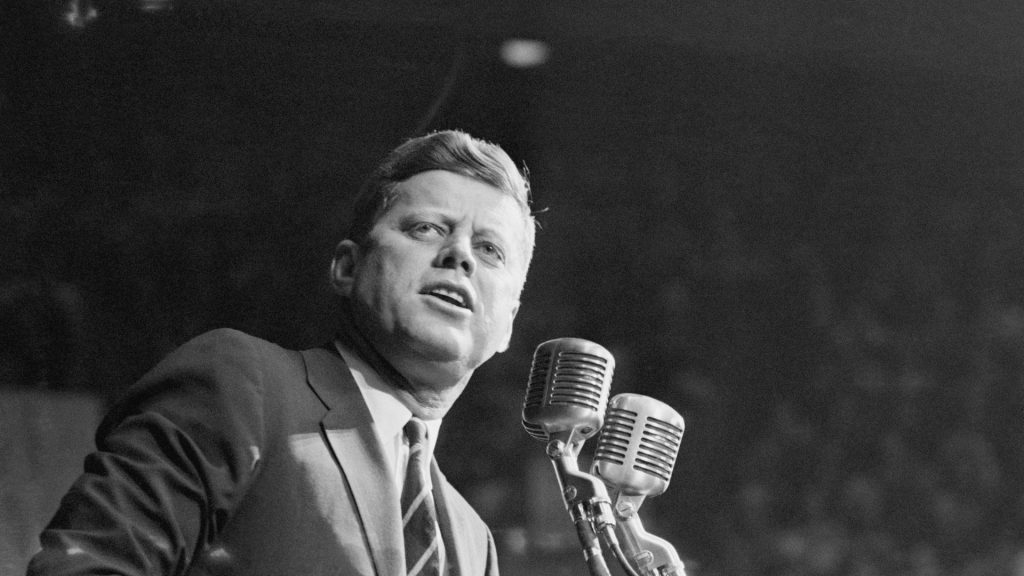The history of food stamps and where it goes from here

President Donald Trump has agreed to comply with court orders to partially fund the Supplemental Nutrition Assistance Program. The food benefit, commonly called SNAP, goes back nearly a century in the U.S.
Overall, the number of Americans enrolled in the program has consistently gone up each decade, with some fluctuations at times.
The beginning of food stamps
The first American food stamp program launched on May 16, 1939, with Mabel McFiggin of Rochester, New York, becoming the first recipient.
Over the next four years, that first program would help 20 million people in nearly half the counties in the country.
That timing coincides with the end of the Great Depression and the start of World War II. At the same time, farms in the U.S. were very productive and grew an excess of food.
“In the 1930s, they had a problem of surplus commodities because of the Depression and the decline in demand for food,” Tracy Roof, an associate professor of political science at the University of Richmond who’s currently working on a book about the political history of food stamps, told Straight Arrow News. “But you had starving people, and so there was this outrage when they slaughtered a bunch of hogs and essentially burned meat and let it go to waste. And it led to a political push to create some kind of way to distribute that food to people in need.”
That program used color-coded stamps. For every $1 worth of orange stamps purchased, 50 cents worth of blue stamps were given. Orange stamps could be used to purchase any food, similar to the SNAP program today. Blue stamps could only be used to purchase from the surplus.
“It was a very popular program because it reserved a sense of decency,” Christopher Bosso, author of “Why SNAP Works: A Political History—and Defense—of the Food Stamp Program,” told Straight Arrow News. “That people were not standing in that line for a box of food. They were actively consumers, and they had some choice.”
That program came to an end in 1943, “since the conditions that brought the program into being, unmarketable food surpluses and widespread unemployment, no longer existed,” according to the USDA website.
Birth of modern food stamps
The program as Americans recognize it today began in 1959, when Congress authorized the secretary of agriculture to operate a food stamp system through 1962.
However, former President Dwight D. Eisenhower never used that authority to launch a program. His successor, John F. Kennedy, used it immediately and made it a big part of his campaign, especially during stops in Appalachia.
“You have pockets of real poverty and need in Appalachia, in particular, in the South and the Delta and in other areas,” Bosso said.

Kennedy’s first executive order, issued upon taking office in 1961, called for expanded food distribution. Less than two weeks after his inauguration, he announced the launch of food stamp pilot programs.
“It turned out to be very successful, and it was kind of based on the model we have today,” Roof said. “You got an amount of food stamps that you were able to go into a store and purchase food. Unlike the Great Depression era program, it didn’t have to be surplus commodities.”
That program then became permanent under Lyndon B. Johnson, Kennedy’s successor, with the passage of the Food Stamp Act of 1964.
“Those days, you would buy, say, $10 worth of food stamps,” Bosso said. “You would get another $4 in free food stamps. So, it’s effectively a 40% discount. And you would take your food stamps to the store and use them as currency to buy food.”
Big changes to food stamps
The food stamp program continued to expand for the next several decades under presidents like Richard Nixon and Jimmy Carter. The latter’s Food Stamp Act of 1977 eliminated the requirement for recipients to purchase food stamps.
Ronald Reagan made significant reforms to the food stamp program, which reduced the amount of funding allocated.
The Food Stamp Act of 1985 made it more difficult to qualify for food assistance, requiring job searching and training as qualifications, a decision that sparked protests, as it occurred during a recession.

“Reagan essentially throws in the towel on food stamps as time goes on and basically comes to agree with Congress about stabilizing the food stamp program,” Bosso said. “And you see a slow growth again, in enrollment over the 1980s.”
The Reagan years also brought about Electronic Benefit Transfer, or EBT. The Hunger Prevention Act of 1988 opened up the pilot programs that would eventually allow recipients to receive their benefits on a debit card instead of paper coupons.
Bill Clinton signed a dramatic welfare reform bill in 1996 that had a large impact on the food stamp program.

“It caused a lot of changes at the state level in the way they administered welfare,” Roof said. “And it also led to a lot of families falling off of food stamps.”
Those changes brought more disqualification provisions, time limits on how long beneficiaries could receive food stamps and made most legal immigrants ineligible for the program.
Former Republican Speaker of the House Newt Gingrich proposed consolidating all nutrition programs into a block grant to states, a move his fellow Republicans deemed a step too far.
“Americans may be ideologically opposed to welfare in some abstract sense, but they also don’t want to see their fellow Americans go hungry,” Bosso said. “So, food stamps have always enjoyed a fair bit of bipartisan support over the years.”
George W. Bush welcomed legal immigrants back to the program with the passage of the Farm Security and Rural Investment Act of 2002. Six years later, Bush officially renamed the program as the Supplemental Nutrition Assistance Program, or SNAP.
Modern SNAP program
Then came the Great Recession in 2008.
“The Great Recession hit, and the numbers really swelled,” Roof said. “A lot of states that hadn’t taken advantage of these options because they wanted federal dollars coming into their states to help stimulate their economy during the recession.”
Gingrich called former President Barack Obama “the food stamp president,” although Obama did not make major changes to the program, other than an increase in benefits towards the end of the Great Recession.
Allotments increased again during Trump’s first term, when the COVID-19 pandemic struck and governors across the country ordered nonessential workers to stay home, and many businesses temporarily shut down. SNAP benefits went up 40% after Trump signed the 2020 Families First Coronavirus Response Act, which temporarily expanded eligibility.
“Enrollment went up,” Roof said. “It never went as high as it had been during the Great Recession, but the size of the benefits grew considerably.”
Those enhanced benefits have since come to an end. Former President Joe Biden’s biggest change came in an increase in payments to recipients after having the USDA reevaluate the plan.
Big changes are coming once again, following Trump’s budget bill earlier this year. Since Kennedy’s program began, the federal government has borne most of the financial burden of food stamps, with states only paying for administrative costs.
That changes with the reforms in Trump’s One Big Beautiful Bill Act.
“It’s going to start shifting some of the cost back to the states,” Roof said. “The states are not prepared to absorb those costs, and they might start backing off on trying to enroll these eligible families.”
States will soon be required to pay 75% of administrative costs, and states with high “error rates” may be subject to higher payments. Error rates are not the same as fraud; they include things like reporting errors or paperwork mistakes.
“You’re going to see a lot of states, I bet, basically say, ‘Well, this isn’t worth it to us,’” Bosso said. “[The states] may cut back on their efforts to enroll people who are otherwise eligible or maybe decide to opt out entirely, because it’s not required that states participate.”
Whatever direction food stamps take moving forward, both experts SAN spoke to agreed that the reason we have the program in the first place won’t be going anywhere.
“We’re going to have people in need,” Roof said. “And everybody kind of thinks, oftentimes, that food banks can pick up that need, but they just do not. They’re not equipped.”
The post The history of food stamps and where it goes from here appeared first on Straight Arrow News.





